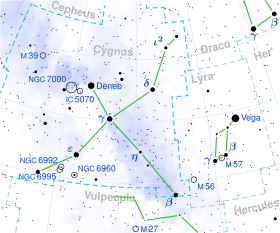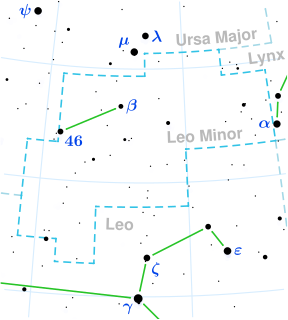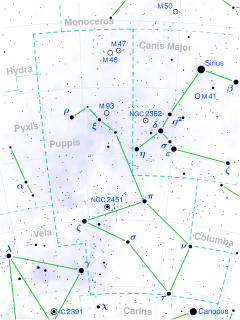| Observation data Epoch J2000 Equinox J2000 | |
|---|---|
| Constellation | Cygnus |
| Right ascension | 20h 57m 10.41907s [1] |
| Declination | 41° 10′ 01.6991″ [1] |
| Apparent magnitude (V) | 3.94 [2] |
| Characteristics | |
| Spectral type | A0III n [3] |
| U−B color index | +0.00 [2] |
| B−V color index | +0.02 [2] |
| Astrometry | |
| Radial velocity (Rv) | −27.60 [4] km/s |
| Proper motion (μ) | RA: +9.64 [1] mas/yr Dec.: −22.75 [1] mas/yr |
| Parallax (π) | 8.71 ± 0.34 [1] mas |
| Distance | 370 ± 10 ly (115 ± 4 pc) |
| Absolute magnitude (MV) | −1.36 [5] |
| Details | |
| ν Cyg A | |
| Mass | 3.62±0.08 [6] M☉ |
| Radius | 1.90 [7] R☉ |
| Luminosity | 412 [6] L☉ |
| Temperature | 9,462 [6] K |
| Rotational velocity (v sin i) | 217 [6] km/s |
| Other designations | |
| Database references | |
| SIMBAD | data |
Nu Cygni, Latinized from ν Cygni, is a binary star [9] system in the constellation Cygnus. Its apparent magnitude is 3.94 [2] and it is approximately 374 light years away based on parallax. [1] The brighter component is a magnitude 4.07 A-type giant star with a stellar classification of A0III n, [3] where the 'n' indicates broad "nebulous" absorption lines due to rapid rotation. This white-hued star has an estimated 3.6 [6] times the mass of the Sun and about 1.9 [7] times the Sun's radius. It is radiating 412 [6] times the Sun's luminosity from its photosphere at an effective temperature of 9,462 K. [6] The magnitude 6.4 companion has an angular separation of 0.24" from the primary. [9]
Latinisation of names, also known as onomastic Latinisation, is the practice of rendering a non-Latin name in a Latin style. It is commonly found with historical proper names, including personal names, and toponyms, and in the standard binomial nomenclature of the life sciences. It goes further than romanisation, which is the transliteration of a word to the Latin alphabet from another script.

A binary star is a star system consisting of two stars orbiting around their common barycenter. Systems of two or more stars are called multiple star systems. These systems, especially when more distant, often appear to the unaided eye as a single point of light, and are then revealed as multiple by other means. Research over the last two centuries suggests that half or more of visible stars are part of multiple star systems.

A constellation is a group of stars that forms an imaginary outline or pattern on the celestial sphere, typically representing an animal, mythological person or creature, a god, or an inanimate object.









